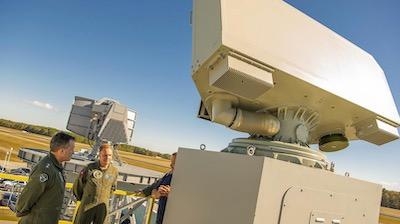Scheduled For Deployment In Fiscal 2021
The Navy demonstrated its new Shipboard Air Traffic Radar, AN/SPN-50, for the first time Oct. 23 at Webster Field in St. Inigoes, Maryland.

The AN/SPN-50 , which is currently in the engineering and manufacturing development (EMD) phase, is scheduled for a production decision in late 2020.The AN/SPN-50 radar will begin replacing the Navy’s current radar system, AN/SPN-43C, on Nimitz-class aircraft carriers and amphibious assault ships in fiscal 2021.
“We're bringing new capability for the warfighter so they can do their job better,” said Capt. Kevin Watkins, Naval Air Traffic Management Systems program office (PMA-213) program manager. “The current radar has been in service since the mid-1960s, and while its mission and procedures remain stable, it’s aging and its analog technology presents inherent performance limitations. A technology update is needed to close supportability gaps and mitigate these performance limitations.”
AN/SPN-50 provides aircraft position, radar signal and radar data at a larger range. Air traffic controllers use the data for aircraft sequencing and separation, airspace identification and containment, safety alerts, weather processing, and landing guidance.
The new digital radar system, with its modern radar processing, improves target detection and tracking in the presence of competing clutter and addresses spectrum restrictions currently experienced with AN/SPN-43C. “ATC surveillance capability is key to reduced launch and recovery cycle times, and current and future sortie rates for the carrier air wing,” Watkins said.
With the new system air traffic controller teams on the ships can actually train onsite on the ship during times when they're not flying and during times when the ship is not deployed. That will also allow the sailors to be ready when called away to go.
AN/SPN-50 is based on the agile production radar system, Sea Giraffe Agile Multi-Beam (AMB), currently operational on the Navy’s littoral combat ships. The U.S .Navy has used the Sea Giraffe AMB since 2005 on its Independence-class LCSs for air and surface surveillance. In addition, AN/SPN-50 provides critical compatibility with the Enterprise Air Surveillance Radar (EASR) whereas EASR and AN/SPN-43C are not as compatible.
The program is scheduled to reach Initial Operating Capability for AN/SPN-50 in late 2022. Following, the first two operational systems are scheduled to be installed; one on aircraft carrier USS Dwight D. Eisenhower (CVN-69), for operational testing, and on the future amphibious assault ship Bougainville (LHA-8), which is currently being built. Twenty five AN/SPN-50 Shipboard Air Traffic Radars are scheduled to be procured through fiscal 2028.
Working side by side with the Naval Surface Warfare Center Philadelphia Division (NSWCPD) from prior to contract award through successful system delivery, a team from the Shipboard Air Traffic Control (ATC) Systems Branch at Naval Air Warfare Center Aircraft Division Webster Outlying Field (NAWCAD WOLF) Air Traffic Control and Landing Systems (ATC&LS) Division helped to execute the successful test of the AN/SPN-50 pedestal and antenna.
“The Shipboard ATC Systems Branch engineering team’s collaboration with NSWCPD, along with their pursuit of detail and engineering soundness, resulted in the successful execution of the shock test of the first mast-mounted, shock-isolated antenna on Navy ships,” said Larry Whites, ATC&LS Division director.
The NAWCAD WOLF team also provided engineering assistance during the program execution in many different areas, including mechanical and electrical engineering, IFF, radar and software expertise as well as system integration work into a shipboard environment; development, submission and coordination of the Ship Change Documentations and associated requirements; coordination with stakeholders; and installation planning.
(Image provided with NAVAIR news release)
 Aero-TV: DeltaHawks Diesel Power Steps Into the Spotlight
Aero-TV: DeltaHawks Diesel Power Steps Into the Spotlight NTSB Prelim: Mooney Aircraft Corp. M20K
NTSB Prelim: Mooney Aircraft Corp. M20K ANN FAQ: Turn On Post Notifications
ANN FAQ: Turn On Post Notifications ANN's Daily Aero-Linx (12.20.25)
ANN's Daily Aero-Linx (12.20.25) Aero-News: Quote of the Day (12.20.25)
Aero-News: Quote of the Day (12.20.25)



